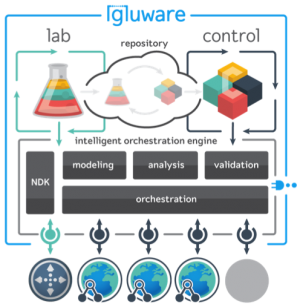































The WAN: Then and Now
The Wide Area Network (WAN) has been at the foundation of enterprise networks for decades: responsible for connecting people, applications and data across a large number of locations. Traditionally, the WAN was relatively static and a "set it and forget it" configuration methodology was acceptable and effective. Management tools were simple and straightforward, yet limited. As an example, while studying for my Routing and Switching CCIE lab exam 15 years ago, I had to become proficient in command line interface, node-by-node configuration and WAN troubleshooting. In order to ensure timely completion of the exam, the use of notepad (scripts) and CLI shortcuts was imperative.
for connecting people, applications and data across a large number of locations. Traditionally, the WAN was relatively static and a "set it and forget it" configuration methodology was acceptable and effective. Management tools were simple and straightforward, yet limited. As an example, while studying for my Routing and Switching CCIE lab exam 15 years ago, I had to become proficient in command line interface, node-by-node configuration and WAN troubleshooting. In order to ensure timely completion of the exam, the use of notepad (scripts) and CLI shortcuts was imperative.
15 years later, many of us still manage our WAN's in the same way: using text files, simple automation tools and scripting engines on a node-by-node basis. While this is reasonably effective on a small-scale network, similar to Metcalfe's Law, the complexity of the network is equal to the number of nodes on the network, squared.
Today, application, cloud, security and other imperatives require the WAN to be dynamic and flexible to meet business needs. The agility and frequency of change the WAN requires is increasing exponentially. In addition, the price/performance of broadband relative to private lines (MPLS/Frame Relay) and the availability of cellular (3G/4G/LTE) has encouraged the adoption of hybrid architectures reducing cost, but increasing complexity. The business is asking IT to do more with less, leverage existing hardware to contain costs, support past and future applications, and be more agile. In order to keep up with these transitions and business requirements, the enterprise needs better tools.
Tools, Tools and More Tools
Many tools already exist to configure the WAN today. Most are one dimensional and work well for specific tasks, but do not allow for extensibility beyond their narrow scope. Note that I'm specifically focused on tools that configure, automate and set policy for the WAN. This is outside the realm of monitoring and visibility, as there are many tools that do this well in customers' networks today. What will be important is the comingling and integration of these applications.
WAN Configuration Approaches:
The end result is a proliferation of tools and solutions used by network engineers to solve the WAN complexity problem. All of these WAN management tools fail to meet the criteria of simplicity, customization and evolution of the network. How we control and service the WAN must change. We do not need more tools; we need an efficient, effective solution.
Gluware 2.0: One Platform, One Solution

I have previously blogged about the benefits and requirements of a Software Defined WAN and how Glue Networks is making the SD WAN a reality. Today, Glue Networks is introducing the next iteration of our SD WAN solution. Glue Network's platform, Gluware 2.0, is comprised of Gluware Control and Gluware Lab. A software only, cloud-based SD WAN solution, Gluware 2.0 enables simple and robust life cycle management and provisioning of WANs. With Gluware Control, businesses deploy and manage their WAN through an intuitive graphical user interface using pre-built, best practice features and architectures. Control was built with network awareness in mind, so you know the exact state and configuration of each node. Gluware Lab provides broad solution customization possibilities, allowing new levels of network modeling and abstraction that can be deployed quickly, securely and predictably across a WAN. This allows for business innovation and agility never imagined. Combine this with the ability to integrate with existing monitoring tools, and Gluware 2.0 solves the decades old tool dilemma for enterprises, service providers and Value Added Resellers.
The end result is a platform that boosts WAN agility, simplifies WAN complexity and enables network evolution with current and future hardware, at scale. The combination of customization and simplicity at scale is a game changer. At last, there is one platform to manage deployment and lifecycle services of the WAN, designed by network engineers for network engineers.
More information on Glue Networks and how we can help with your SD WAN and orchestration needs can be found below:
 Etiquetas calientes:
SDN
Cisco SD-WAN
IWAN
Glue Networks
Gluware
Etiquetas calientes:
SDN
Cisco SD-WAN
IWAN
Glue Networks
Gluware